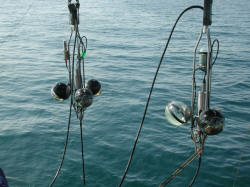The Fermi Large Area Telescope (Fermi-LAT) has detected a diffuse emission of high-energy gamma-ray photons (up to several TeV) from the inner part of the Milky Way known as the Galactic Ridge. A similar neutrino flux is expected from the same sky region if this emission is dominated by proton and nuclei interactions.
The ANTARES collaboration has performed a search for such neutrinos using data collected between 2007 and 2020. Both track-like events (dominated by muon neutrino charged-current interactions) and shower-like events (for which electron neutrino charged-current interactions and neutral current interactions are contributing) have been analyzed. The analysis is restricted to the region |l|<30° and |b|<2° (respectively galactic longitude and latitude).
The reconstructed energy distributions are inconsistent with the background expectation and the observed excess is about 2σ. The best-fit all-flavour neutrino flux is:
dN/dE = ϕ·(E/40 TeV)-Γ with ϕ = 4.0+2.7−2.0·10−16 GeV−1 cm−2 s−1 sr−1 and Γ = 2.45+0.22−0.34
This is consistent with the expected neutrino signal if the bulk of the observed gamma-ray flux from the Galactic Ridge originates from interactions of cosmic ray protons and nuclei with a power-law spectrum extending well into the PeV energy range, as shown in the figure below.
The detailed method and results are available in the arXiv preprint.



